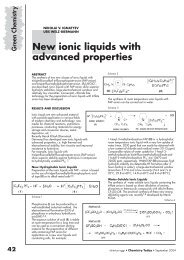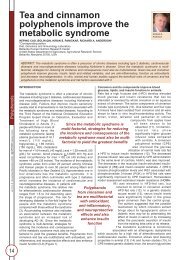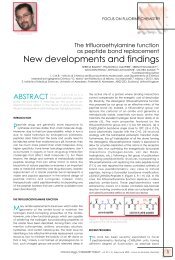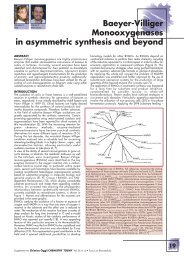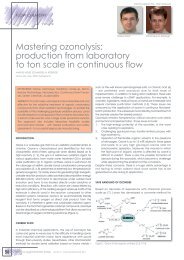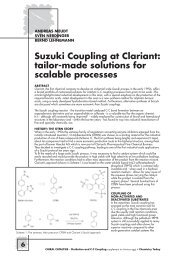Lake Como 2|4 October 2011 - CHIMICA Oggi/Chemistry Today
Lake Como 2|4 October 2011 - CHIMICA Oggi/Chemistry Today
Lake Como 2|4 October 2011 - CHIMICA Oggi/Chemistry Today
Create successful ePaper yourself
Turn your PDF publications into a flip-book with our unique Google optimized e-Paper software.
Novel process windows<br />
Boosted organic chemistry under harsh reaction conditions in microreactor<br />
Qi Wang, Volker Hessel<br />
Eindhoven Univ. of Technology (TU/e), Dept. of Chemical Engineering and <strong>Chemistry</strong>, Micro Flow <strong>Chemistry</strong> & Process Technology<br />
Den Dolech 2, 5600 MB Eindhoven, The Netherlands<br />
Microreactors possess high mass/heat transfer capability which provides a transport intensifi cation fi eld (1). For many organic<br />
reactions, however, this on its own is not enough to ensure productivity (and sometimes selectivity) high enough to be competitive,<br />
especially for an industrial application. A second chemical intensifi cation fi eld rather has to be added. Novel Process Windows<br />
(NPW) stand for the use of highly intensifi ed, unusual and typically harsh process conditions to boost micro process technology and<br />
fl ow chemistry for the fi ne chemical production (2-3). In extension, NPW give emphasis to a third process-design-intensifi cation<br />
fi eld through process simplifi cation and integration. Five projects under the umbrella of the ERC Advanced Grant on Novel Process<br />
Windows (NPW) are in the process of making fundamental investigations here (started April <strong>2011</strong>). The ERC research aims to<br />
be comprehensive and holistic: starting from a molecular-mechanistic (New Chemical Transformations) and kinetic scale (High-<br />
Temperature/pressure Processing) (4-5) via the scale of reaction environment (Solvent-free<br />
Operation and Tuneable/ eactive Solvents) (6-7) up to a process scale (Process Integration<br />
and Simplifi cation).<br />
POSTER POSTER POSTER POSTER POSTER POSTER POSTER POSTER POSTER POSTER POSTER POSTER POSTER POSTER POSTER POSTER POSTER POSTER POSTER POSTER POSTER POSTER POSTER POSTER POSTER POSTER POSTER POSTER POSTER POSTER POSTER POSTER POSTER POSTER POSTER POSTER POSTER POSTER POSTER POSTER POSTER POSTER POSTER POSTER<br />
9<br />
The 1,3-Huisgen cycloaddition-based triazole Click <strong>Chemistry</strong> is explored in a micro-capillary<br />
fl ow reactor with two objectives:<br />
1) high-p, T processing using two-step fl ow synthesis starting from inorganic azide; aim -<br />
process simplifi cation to catalyst-free route<br />
2) copper-catalyzed processing using one-step fl ow synthesis starting from hazardous<br />
organic azide; aim - process simplifi cation to one elemental path by using smart catalyst.<br />
Simplifi cation is also the motif for process design analysis of the oxidation of cyclohexane/<br />
cylcohexene:<br />
1) multiple chemically advanced routes with the classical air oxidant of cyclohexane (or by<br />
photo and even ozone) to cyclohexanone (even further to ε-caprolactam) or formation<br />
of oxime from cyclohexane by using nitrosyl chloride;<br />
2) one-step direct oxidation of cyclohexene to adipic acid with hydrogen peroxide (or even<br />
ozone) as oxidant;<br />
3) double-direct route starting from H 2 and O 2 .<br />
The known chemical rate acceleration of the Claisen rearrangement through high-p, T<br />
processing will be used for subtle mechanistic analysis on:<br />
1) selectivity and stereoselectivity issues at ring intermediate;<br />
2) increasing space-time yield under the correspondingly short residence times, all<br />
accompanied by theoretical considerations.<br />
Selectivity and conversion effects through tunable solvents and process integration (reactionseparation)<br />
are studied for the n-octene hydroformylation:<br />
1) supercritical CO2 to decrease phase number;<br />
2) nanoporous membranes for homogeneous catalyst separation;<br />
3) possibly fl uorous solvents for catalyst separation;<br />
4) possibly heterogeneous catalyst. Such new process chemistry will provide new conceptions<br />
for system (multi-scaled multi-integrated microreactors) and process design at a pilot and<br />
production level.<br />
Through cost- and life-cycle analysis in a generic way it shall be ensured that the fi ndings are<br />
mutually exploited and then can be transferred to a large number of reactions.<br />
(1) Wirth T., Microreactors in organic synthesis and catalysis, Wiley-VCH, 2008.<br />
(2) Hessel V., Renken A., et al., Handbook of micro-reactor engineering and micro-reactor<br />
chemistry, three-volume edition, Wiley-VCH, Weinheim, 2009.<br />
(3) Hessel V., Chem. Eng. Technol. 32 (2009) 1655-1681.<br />
(4) Razzaq T., Glasnov T. N., et al., European J. Org. Chem. (2010) 1321-1325.<br />
(5) Murphy E. R., Martinelli J. R., et al., Angew. Chem. Int. Ed. 119 (2007) 1764.<br />
(6) Bourne R. A., Han X., et al., Angew. Chem. 121 (2009) 5426 –5429.<br />
(7) Mehnert C. P., Cook R. A., et al., J. Am. Chem. Soc., 124 (2002) 12932-12933<br />
27<br />
<strong>Lake</strong> <strong>Como</strong><br />
<strong>2|4</strong> <strong>October</strong> <strong>2011</strong>



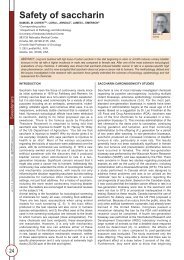
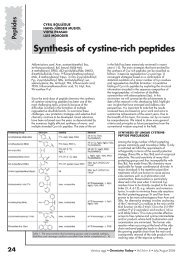
![Pietro Delogu [modalità compatibilità]](https://img.yumpu.com/12255149/1/190x135/pietro-delogu-modalita-compatibilita.jpg?quality=85)
